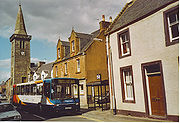
Strathmiglo
Encyclopedia

Ordnance Survey
Ordnance Survey , an executive agency and non-ministerial government department of the Government of the United Kingdom, is the national mapping agency for Great Britain, producing maps of Great Britain , and one of the world's largest producers of maps.The name reflects its creation together with...
) is a village in Fife
Fife
Fife is a council area and former county of Scotland. It is situated between the Firth of Tay and the Firth of Forth, with inland boundaries to Perth and Kinross and Clackmannanshire...
, Scotland
Scotland
Scotland is a country that is part of the United Kingdom. Occupying the northern third of the island of Great Britain, it shares a border with England to the south and is bounded by the North Sea to the east, the Atlantic Ocean to the north and west, and the North Channel and Irish Sea to the...
on the River Eden. The population is around 1000. Nearby settlements include Auchtermuchty
Auchtermuchty
Auchtermuchty is a town in Fife, Scotland, situated beside Pitlour Hill nine miles north of Glenrothes. Until 1975 it was a royal burgh, established under charter of King James V in 1517. There is evidence of human habitation in the area dating back over 2,000 years, and the Romans are known to...
and Falkland
Falkland, Fife
Falkland is a town and former royal burgh, formerly known as the Parish of Kilgour c1300AD in Fife, Scotland at the foot of the Lomond Hills.According to the 2008 population estimate, the village has a population of 1,180.- History :...
.
Strathmiglo is sometimes thought to have belonged to the Mormaers of Fife in early times. Before 1350 it had become the centre of the shire
Shire
A shire is a traditional term for a division of land, found in the United Kingdom and in Australia. In parts of Australia, a shire is an administrative unit, but it is not synonymous with "county" there, which is a land registration unit. Individually, or as a suffix in Scotland and in the far...
of Strathmigloshire. It became a burgh of barony
Burgh of barony
A burgh of barony is a type of Scottish town .They were distinct from royal burghs as the title was granted to a tenant-in-chief, a landowner who held his estates directly from the crown....
in the 16th century, by which time it belonged to the Scotts of Balwearie. Prior to the Reformation
Scottish Reformation
The Scottish Reformation was Scotland's formal break with the Papacy in 1560, and the events surrounding this. It was part of the wider European Protestant Reformation; and in Scotland's case culminated ecclesiastically in the re-establishment of the church along Reformed lines, and politically in...
it was the site of a Collegiate church
Collegiate church
In Christianity, a collegiate church is a church where the daily office of worship is maintained by a college of canons; a non-monastic, or "secular" community of clergy, organised as a self-governing corporate body, which may be presided over by a dean or provost...
.
The economic life of the burgh in early times was linked to nearby Falkland Palace
Falkland Palace
Falkland Palace in Falkland, Fife, Scotland, is a former royal palace of the Scottish Kings. Today it is in the care of the National Trust for Scotland, and serves as a tourist attraction.-Early years:...
. In the 18th and 19th centuries the textile industry was important, as was boot-making in the 20th. The tollbooth of 1734 is a prominent landmark and there is a Pictish stone
Pictish stones
Pictish stones are monumental stelae found in Scotland, mostly north of the Clyde-Forth line. These stones are the most visible remaining evidence of the Picts and are thought to date from the 6th to 9th centuries, a period during which the Picts became Christianized...
by the cemetery.
External links
- Strathmiglo & Gateside community website
- Strathmiglo in the Second Statistical Account of c. 1845
- Strathmiglo at the Gazetteer of Scotland

